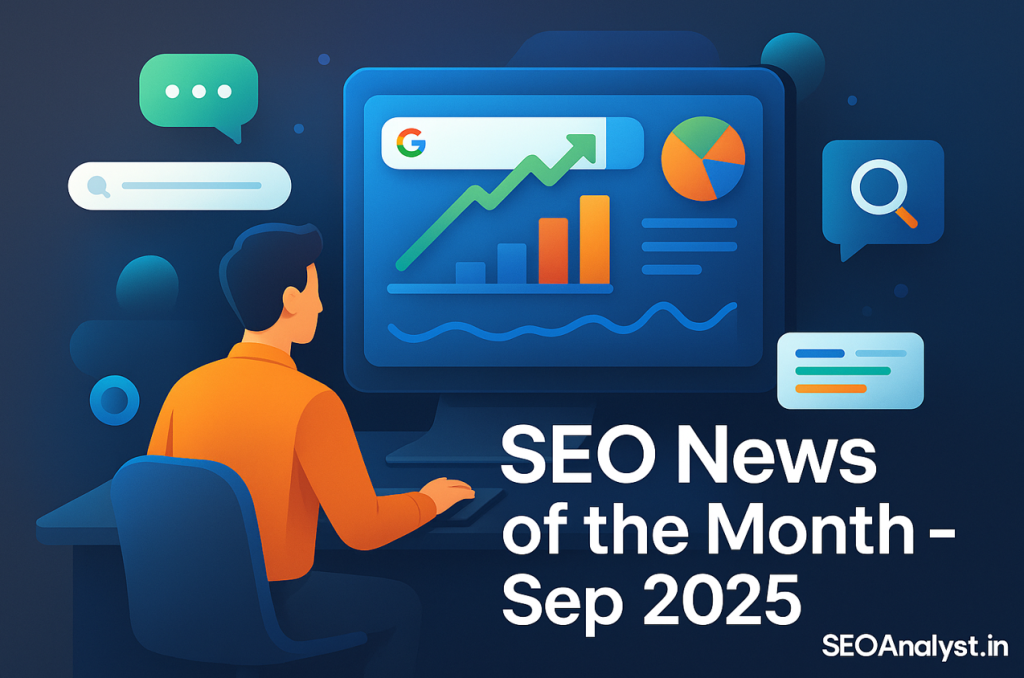
September was a month where search fundamentals and AI-driven disruption collided. Google ended support for the &num=100 parameter, rolled out a broad Spam Update, and gave users more control in Top Stories. At the same time, AI-powered search engines like ChatGPT and Perplexity showed reliability cracks, Chrome introduced Gemini AI integration, and publishers escalated their pushback against AI Overviews.
For marketers, the message is clear: measurement is changing, AI is reshaping discovery, and content quality is under sharper scrutiny than ever.
Google disables &num=100 parameter, altering rank tracking and Search Console impression data. Source from Search Engine Land.
August 2025 Spam Update completed (Sept 22), targeting thin AI-generated content, cloaking, and doorway tactics. Source from SE Land
Ahrefs study: AI search engines send users to broken links ~7× more often than Google, with ChatGPT the worst offender. Source
Gemini AI lands in Chrome, offering summaries, cross-tab Q&A, and early “AI Mode.” Source
Penske Media sues Google over AI Overviews; Google updates Quality Rater Guidelines to evaluate AI answers. Source – The Verge
Preferred Sources launches in Top Stories (US & India), giving readers more influence over what news outlets they see. Source
TikTok Search Ads deliver 2× purchase lift, proving Gen Z treats TikTok as a search engine. Source
For years, SEOs used &num=100 to see 100 results per page. In September, Google confirmed it no longer supports the parameter. Rank trackers relying on it showed wild fluctuations, and Google Search Console impressions dropped — not due to less demand, but due to fewer results being logged.
Google said the feature was “never formally supported,” and its removal also curbs scraping activity.
Takeaway: Expect lower impression counts post-September. Focus client reporting on clicks, positions, and conversions, not raw impression volume.
The August 2025 Spam Update (Aug 26 – Sept 22) hit thin AI content, aggressive internal linking, and doorway-style tactics. Some sites penalized in past updates recovered after cleanup.
What to audit now:
Google’s Preferred Sources lets logged-in users follow publishers, giving them more weight in Top Stories. This blends SEO with audience building — publishers that drive opt-ins through newsletters or communities gain an edge.
Practical step: Prompt your audience with “Follow us as your preferred source on Google” CTAs. For Indian publishers, this is a chance to lock in recurring visibility.
An Ahrefs study of 16M URLs found AI assistants (ChatGPT, Perplexity, Claude, Bing Copilot) send users to broken pages far more often than Google. ChatGPT had the worst record: 1.01% of clicks led to 404s vs. Google’s 0.15%.
Google’s John Mueller even suggested optimizing your 404 pages to salvage AI-driven misclicks.
Action: Track your 404 analytics closely. Add search bars, popular articles, or product CTAs to capture AI-driven visits.
Google introduced Gemini AI integration in Chrome, with features like:
This means some “searches” won’t even hit Google SERPs — they’ll be answered directly in the browser.
Optimize for summarization:
Rolling Stone’s parent company sued Google, claiming AI Overviews cut clicks and cost millions in affiliate revenue. In parallel, Google updated its Quality Rater Guidelines to tell evaluators to judge AI answers, not just web results.
Lesson: Content needs originality and depth AI cannot replicate. Add charts, exclusive data, or expert POV that forces the click.
As I’ve seen in SaaS SEO, “value beyond the snippet” is now a survival tactic.
Screaming Frog SEO Spider rolled out updates including:
SEMrush study: Across 150K+ AI responses, Reddit was the top-cited source, outranking Wikipedia and YouTube.
Organic Labs report: AI prefers structured content (lists, FAQs, schema) and consistent entity mentions.
Action:
OpenAI posted for a Growth – SEO, CRO, Web Strategy role, hinting at a possible ChatGPT.com domain migration. If the world’s biggest AI player needs SEO expertise, it reinforces the message: SEO is not dead — it’s essential for AI adoption.
TikTok revealed that adding Search Ads doubled purchase lift, with 86% of Gen Z using TikTok search weekly. For retail, ROI was even stronger.
Marketer move: Treat TikTok as a visual search engine. Use keyword-rich captions and hashtags, and create 30–60s videos answering queries (e.g., “best budget SaaS tools”).
Instagram finally launched an iPad app — and it opens directly to Reels. This confirms Meta’s short-form video priority.
Action: Repurpose blog posts into micro-Reels with hooks, captions, and strong CTAs.
Hank Green’s Focus Friend app (an ADHD productivity tool) surged to #1 on the App Store, outranking even ChatGPT. The trend: creators are moving from promoting products to creating them, leveraging trust to win markets fast.
September 2025 made one truth undeniable: SEO is no longer just about 10 blue links. Discovery happens via SERPs, browser-integrated AI, social search, and community forums.
The next wave of winners will be those who:
October is set to bring more experiments in AI integration and possibly another round of volatility. My advice? Build a living playbook: track updates, annotate changes, and refine your content operating system for both Google and AI search.
Update 1: Here is an exclusive coverage of the “SEO News of the Month – October 2025“
Update 2: Newer editions available: Jump to November 2025 for the latest AI + SEO changes.
👉 Latest AI SEO News – November 2025
👉 Update 3: Newer editions available: Jump to Latest AI SEO News of the Month December 2025.
👉 Follow Manikandan N on LinkedIn for weekly insights on AI-powered SEO, entity optimization, and how India’s search landscape is evolving with generative AI.
Stay ahead of Google updates, AI search experiments, and SEO automation workflows with insights from global top SEO minds. No noise - just what matters, delivered every week.